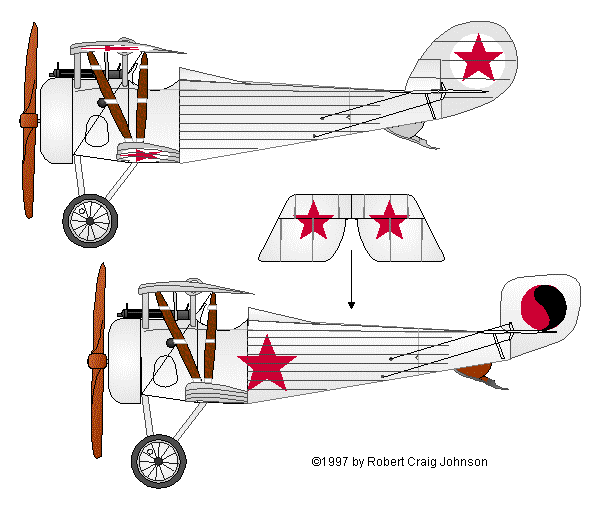
While the Armistice of November 11, 1918 ended World War I in France and Belgium, fighting continued in Eastern Europe and Asian Russia for another two years. France, Britain, and the United States were trying to crush Communism at its outset, while Japan was rushing to expand her foothold in continental Asia. At the same time, supposedly demobilized German combat veterans were seeking compensation for the defeat of their Reich in a new eastern empire carved from the Baltic states and the Ukraine by their proto-fascist Freikorps. On the rail line leading south from Archangel, American and British troops were fighting Bolsheviks in front and pro-German Finns on their flanks. French, British, and reactionary, White Russian forces were battling both Reds and Germans in the Baltic and around the Black Sea. Royal Navy warships, aircraft, and motor torpedo boats were raiding Red Fleet anchorages. Myriad, competing nationalities sprang from the decaying, multi-ethnic Austrian and Russian empires and set about fighting their former masters and each other. Czechs fought Russians, Poles, and Hungarians. Hungarians fought Rumanians. Poles fought Russians, Ukrainians, and Lithuanians, who also battled the Germans and Russians, as did the Latvians and Estonians. Cossacks fought everyone. At the same time, Finns, Hungarians, Bulgarians, Germans, and Russians fought among themselves, Red against White, in bloody revolutions and counter-revolutions.
In this turbulent new phase of the war, the infant Soviet Union was at a serious disadvantage. The mutinous spirit that had brought Lenin and his Party to power was not conducive to military discipline and national defense. The pacifist rhetoric of the Bolshevik activists and the restrictions imposed by the Brest-Litovsk treaty had made it impossible to form a viable army in the year following the Revolution. All the best generals and many of the best troops in the old Imperial Army were now fighting with one or more of the new nation's enemies. At one point, a single regiment of Latvians was the only loyal unit available to the Bolshevik central government. Modern equipment was unavailable or culled from worn-out, non-standard Allied, Austrian, and German material abandoned in dumps or captured from prisoners.
In spite of these handicaps, an energetic amateur, the famous Leon Trotsky, soon achieved what few military professionals could do. He created a large, disciplined, and, ultimately, victorious army from a few Red Guards and a great many unwilling draftees. His opponents proved unable to match it despite a professional officer corps, experienced men, and vastly superior equipment.
From the first, the Soviets sought to create a Red air force to cover and support their army. Surviving Czarist-era airplanes were gathered together, repaired, and put back into service. The mainstays of the pre-revolutionary air arm, Nieuports and SPADS, predominated, their Imperial roundels overpainted or adapted to reflect their new allegiance. But even types that were long since obsolete —Nieuport 10s, 11s, and 12s, Farmans, and Albatros B.IIs—were thrown into front-line combat. Captured aircraft were hastily repaired, repainted, and put into service against their former owners. There were few aircraft on either side, however, and thousands of miles of front. Air combat was accordingly rare, though Soviet pilots often proved able to hold their own in a fight. Fighters were most often used for scouting or strafing the cavalry columns and armored trains that predominated in the vast open spaces of western and southern Russia.
Below, Nieuport Ni. 27, unidentified Red Army unit, 1919-20.

Above, Ni. 24bis, No. 1 Soviety Szyrynkin Group 1, Col. P. Abakanowicz. Below, Red Army Ni. 21 (?) formerly of 4th Eskadra of the Imperial air service.
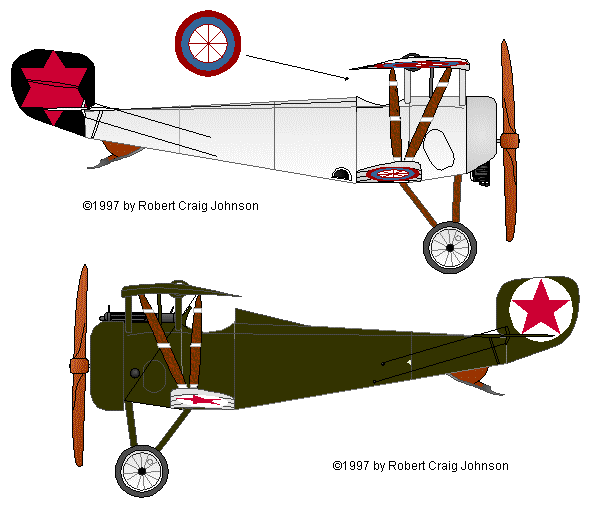
Above, Ni 17 or 23, captured by Polish 1st Wielkopolska Rifle Division, Lithuanian- Byelorussian front, 1919. Below, Ni. 24bis, unidentified Red Army unit.
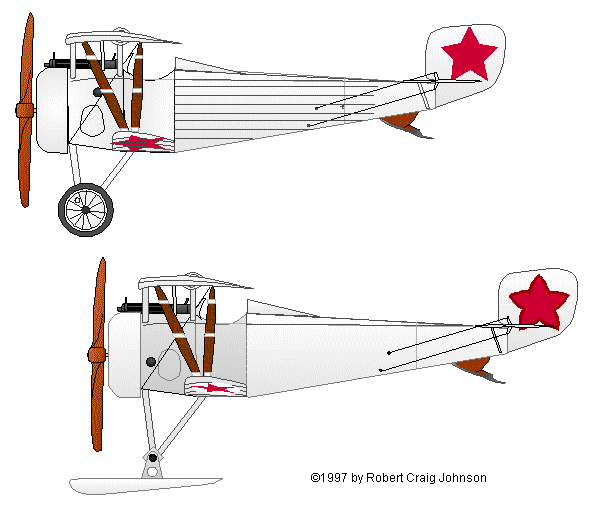
Above, French-built Ni. 23 N4218 (?), unidentified Red Army unit. Skis were a standard fitting in winter. Below, Duks-built Ni. 23, 1st Fighter Detachment, Northern Hydro-aviation Battalion, Red Navy, North Dvina front, summer 1919.
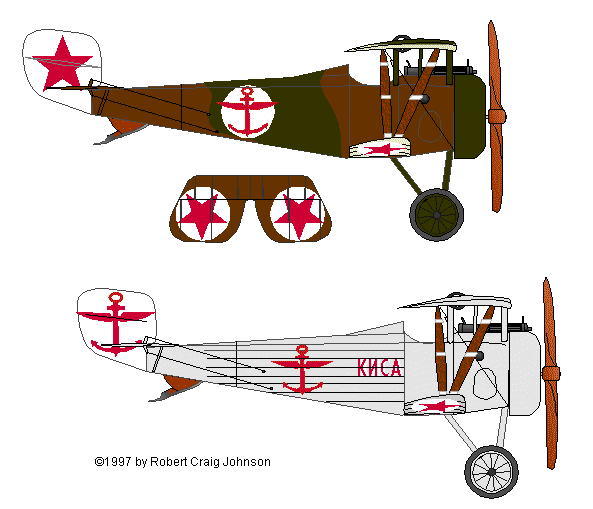
Above, French-built Ni. 24bis, 1st Fighter Detachment, Northern Hydro-aviation Battalion, Red Navy, North Dvina front, 17 June 1919. Below, French-built Ni. 24bis (Ni. 27?), 1st Fighter Detachment, Northern Hydro-aviation Battalion, Red Navy, North Dvina front, 23 May 1919.
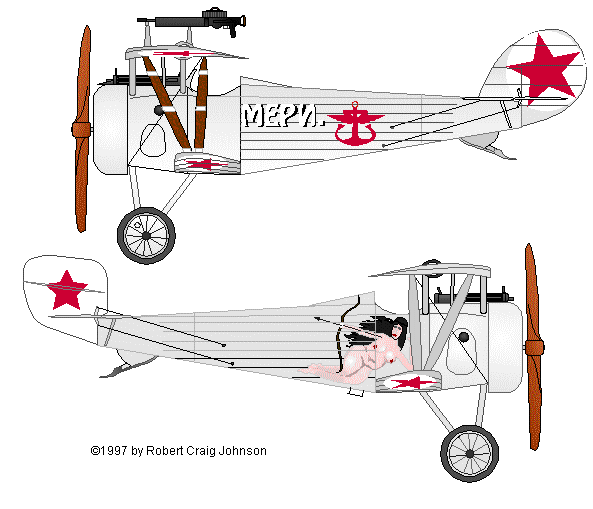
Above, Ni. 24bis N. 5086, 4th Artillery-Cooperation Squadron, Red Army, captured by Poles on a rail-road flatcar near Vilnius, later flown by Julius Gilewicz, 5th Squadron, Polish air service. Below, SPAD 7, 1st Fighter Detachment, Northern Hydro-aviation Battalion, North Dvina front, summer, 1919
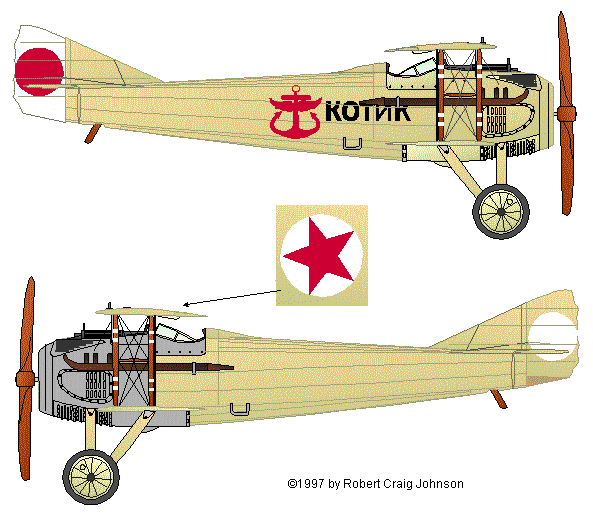
Above, SPAD 7, unidentified Red Army unit
The only other Communist air force at this time was the Hungarian Red Airborne Corps. When Bela Kun declared the Hungarian portion of the Austro-Hungarian Empire a worker's republic, experienced, Hungarian pilots and mechanics from the old Empire made the air force of the new state one of the most efficient in Eastern Europe. Equipment was also first-rate: MAG-built Fokker D.VIIs with powerful, 230-hp Austro-Daimler engines and, in a few cases, twin-barreled, motor-driven Gebauer machine guns. These fighters saw combat against invading Czech, Serbian, and Rumanian forces. Many were later incorporated into the Czech air force.
Below, Fokker-built D.VII with 230-hp Austro-Daimler engine, Hungarian Red Airborne Corps, 1919.
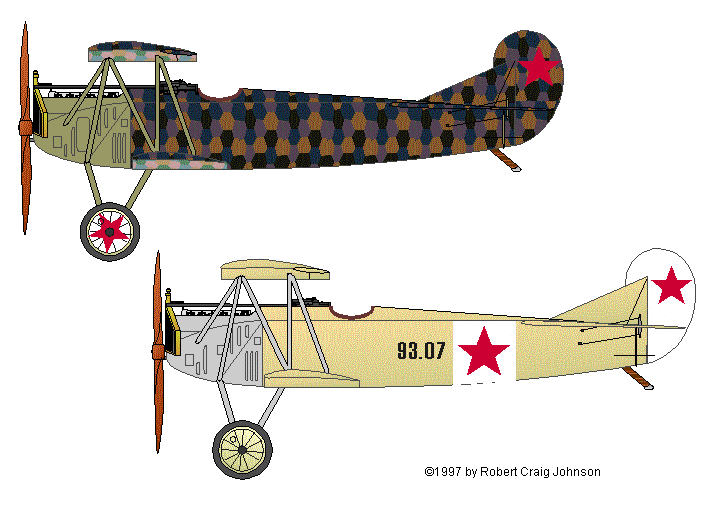
© 1997 by Robert Craig Johnson.